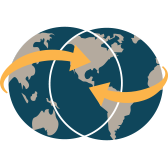Saudi Arabia and Turkey are not the only countries influencing societies in Southeast Europe. China and Russia also have a presence, particularly in infrastructure investment and the media. The United States is conspicuously absent in the region, both politically and economically. If the United States continues to sit on the sidelines, Washington risks ceding political and economic influence to countries who have developed and maintained a presence across the region—and whose own interests might run counter to those of the United States.
Russia, with its demonstrated wish to undermine Western interests, is the biggest cause for concern. Although there is almost no risk of Russia taking direct military action—for both demographic and geographic reasons—as it did in the 2008 invasion of Georgia[i] and the 2014 annexation of Crimea in Ukraine,[ii] it is clear that Russia is “trying to undermine and shame the U.S. and the West’s success story,” according to Ilir Deda, a member of Kosovo’s parliament. “There is the potential for Russia or the U.S. to light the fuse,” says one Serbian government official, with larger powers using regional proxies to exert influence, fueled by rising nationalism, military partnerships, and security concerns. Russian President Vladimir Putin has met twice with President Dodik of Republika Srpska since 2014[iii] and with Serbian President Nikolić on three occasions since 2013.[iv] In a sign of the two countries’ religious and cultural ties, the Russian ambassador was officially ordained as the “guardian of the Serbian people, especially in Kosovo,” by the Serbian Orthodox Church.[v]
When it comes to Belgrade’s relationship with Moscow and the West, Serbia “sits on two chairs,” says one politician. President Nikolić is known to be supportive of Russia’s agenda. By comparison, Serbian Prime Minister Aleksandar Vučić is pushing for EU membership. When it comes to Serbia’s preference for the EU or Western systems, the answer is that “it’s complicated.” The government of Serbia is pursuing EU membership[vii] and has achieved the closest possible partnership with NATO without becoming a member[viii]—a consequence of low public support—reflecting a desire for the hallmarks of a liberal society and economy: rule of law, freedom of the press, and open markets.
The ties between Russia and Serbia are equally complicated. On the one hand, the two countries, as well as Republika Srpska, share a common religion—a potent unifying force in this region. However, some interviewees, including journalists and politicians, say that when it comes to Russia, the “Slavic Brotherhood” bond is predominantly “emotional” and “an illusion,” albeit a powerful one. Few younger Serbs speak Russian or have traveled to Russia, particularly when compared with the growing number of English-speaking citizens.[ix] Yugoslavia’s expulsion from the Communist Information Bureau in 1948 led Tito, the former leader of Yugoslavia, to help found the Non-Aligned Movement in 1961, reducing Cold War–era ties to the Soviet Union. What remains important is the notion that “Russia has Serbia’s back,” having stood up for the country as it was roundly criticized by much of the world for being the aggressor in the wars of the 1990s. “I am concerned when Russia makes statements in which it says that boundaries in Bosnia and Herzegovina and the region will change and that there is unfinished business,” says one Serbian civil society activist. “This type of manipulation is not soft power.”
Russia’s financial stake in Serbia’s economy is not particularly large, amounting to an average of approximately 5 percent of total foreign investment from 2001 to 2014.[x] According to the Serbian Chamber of Commerce, Russia has invested in oil and gas, but “other than that there are not many investments from Russia.” However, a presence in the energy market is an effective way to influence domestic politics and Russia has a track record of doing so elsewhere, notably in Ukraine. Had the South Stream natural gas pipeline deal gone through—sanctions scuttled the plan in 2014—Russia would have had much more influence in Serbia.
Russia has a strong media presence in Serbia.[xi] At a time when major international networks are pulling out—BBC Serbia and Radio Free Europe, for example, have closed their Belgrade offices—Russia is developing and increasing its presence through media brands such as Sputnik News and RT. Not only are outfits associated with the Russian lobby in Belgrade buying networks and entering the broadcast market, they are also, according to one Serbian opposition politician, financing individual journalists. The official U.S. government–funded broadcasting institution, Voice of America, by contrast, is described as being “not influential.”
China, which also backed Serbia during the war with Kosovo, has a growing presence in the region—and in Serbia in particular—one that is based on China’s interests in developing its own New Silk Road economic plan.[xii] Chinese investments, like Russian ones, are concentrated primarily in energy, but also in infrastructure. In 2014 Serbia and China signed thirteen agreements and memoranda on finance, infrastructure, telecommunications, and investment, according to an article in EUobserver.[xiii] In May 2016, China’s Gezhouba Group signed an agreement with Elektroprivreda of Bosnia and Herzegovina for the construction of part of a coal power plant worth roughly €700 million.[xiv] Although the investment is welcome in BiH, there is some frustration that the construction of coal power plants “is not the future we should be moving toward,” according to a businesswoman in BiH. According to a U.S. official, China is investing heavily in BiH and Herzegovina, as Beijing sees BiH as a good opportunity to gain a foothold in Europe, and there are currently more than 100 different Chinese-owned businesses in Sarajevo. By comparison, there are fewer than 50 U.S. companies and business there. As a result, China and Russia are having a large effect on both the economic and political agenda in the region.
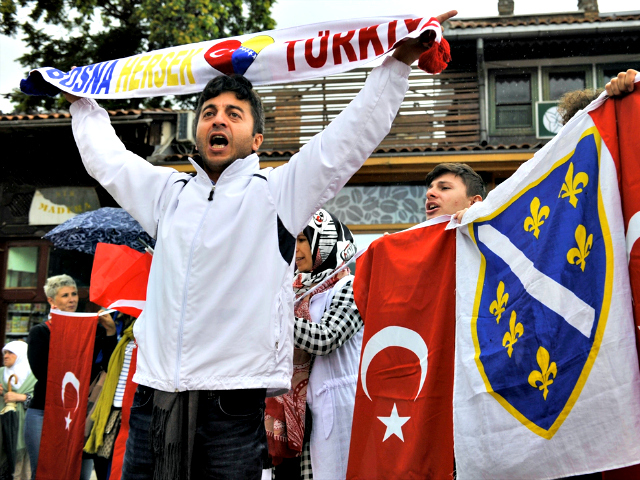
Turkey is also making a strong push in the former borderlands of the Ottoman Empire. During a 2013 visit to Prizren, Kosovo, President Erdoğan of Turkey declared: “We all belong to a common history, common culture, common civilization. We are the people who are brethren of that structure. Do not forget, Turkey is Kosovo, Kosovo is Turkey!”[xv] Turkey, with its Ottoman-era ties to Kosovo, is set to sign a trade deal. More than 700 Turkish businesses already operate in Kosovo and the Turkish International Cooperation and Development Agency (TIKA) supports more than 400 projects in health, education, and agriculture. TIKA sponsors restoration of religious sites in both Kosovo and BiH, including heavy participation in the rebuilding of the Ferhadija Mosque in Bosnia’s Republika Srpska region.[xvi]
Amid all of these other influences, EU countries remain the region’s most significant source of business, and therefore influence. Italy and Germany are top export destinations for each of the countries, and Austria and Slovenia are also important.[1] Moreover, the countries trade with each other, particularly BiH, Croatia, and Serbia. These ties are important and underscore that regardless of influence in other areas, trade remains an important and constructive connector.
Previous: Religion and Radical Islam
Next: Business and the Economy
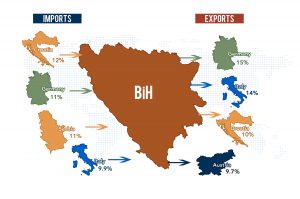
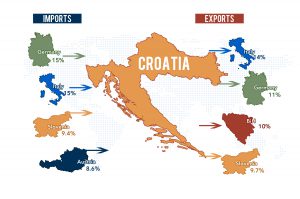
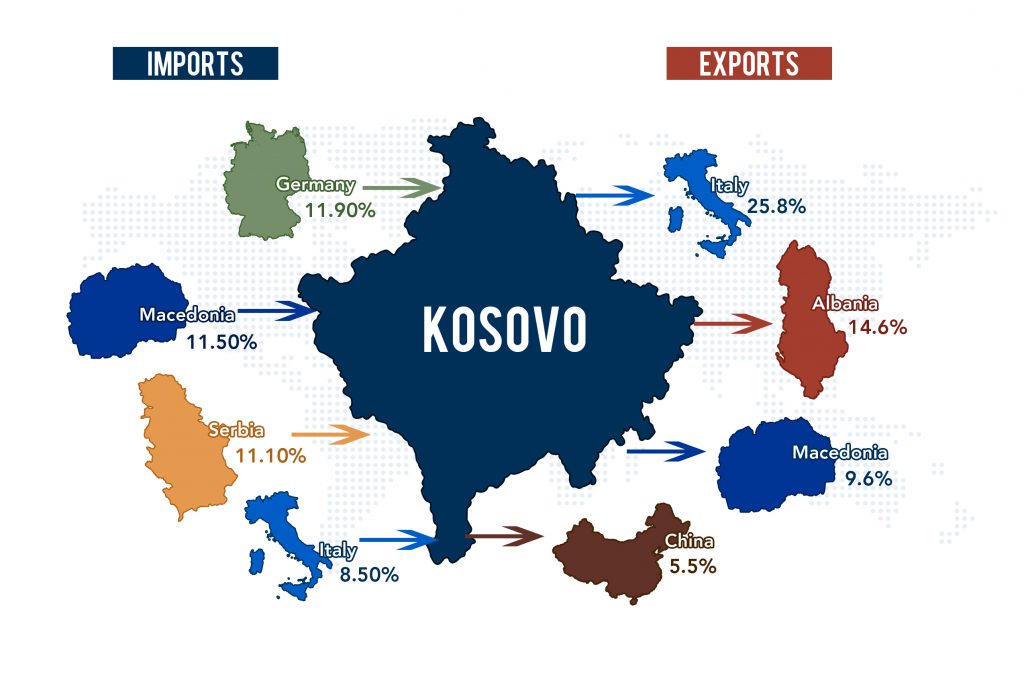
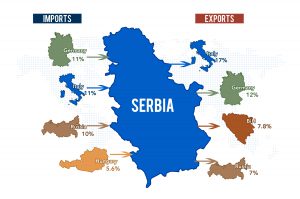
[1] Please see infographics on pages 13-14.
[i] Russian invasion of Georgia; Friedman, G. (n.d.). The Russo-Georgian War and the Balance of Power. Retrieved February 13, 2017, from https://www.stratfor.com/weekly/russo_georgian_war_and_balance_power
[ii] Russian annexation of Crimea; Ukraine: Putin signs Crimea annexation. (2014, March 21). Retrieved February 13, 2017, from http://www.bbc.com/news/world-europe-26686949
[iii] Putin and Dodik meetings since 2014; Dukic, V. (n.d.). Connecting People Through News. Retrieved February 14, 2017, from https://www.pressreader.com/serbia/blic/20160915/281668254436644
[iv] Putin and Nikolic meetings since 2013; Office of the President of the Republic of Serbia. (n.d.). Retrieved from http://www.predsednik.rs/lat/predsednik
[v] Serbian Orthodox Church honors the Russian Ambassador; Martinovic, I. (n.d.). Crkva odlikovala ruskog ambasadora u Srbiji. Retrieved from http://www.slobodnaevropa.org/a/crkva_odlikovala_ruskog_ambasadora_u_srbiji/24475623.html
[vi] Putin and Nikolic meeting; http://www.6yka.com/novost/66185/sastanak-nikolic-putin-srbija-vidi-u-rusiji-partnera-i-saveznika-i-to-nece-ugroziti-uvodenjem-sankcija
[vii] Government of Serbia sets EU membership as priority; EU MEMBERSHIP FIRST PRIORITY FOR SERBIAN GOVERNMENT. (n.d.). Retrieved from http://www.predsednik.rs/en/press-center/news/eu-membership-first-priority-serbian-government
[viii] NATO-Serbia Individual Partnership Action Plan; Relations with Serbia. (n.d.). Retrieved from http://www.nato.int/cps/en/natohq/topics_50100.htm
[ix] English language is the first foreign language in the Serbia; Rasic, M. (2017). U srpskim školama dominira učenje engleskog, ali još jedan jezik mu se OPASNO PRIBLIŽAVA. Retrieved from http://www.blic.rs/vesti/drustvo/u-srpskim-skolama-dominira-ucenje-engleskog-ali-jos-jedan-jezik-mu-se-opasno/rk02he9
[x] Russian investments in Serbia; Serbia Foreign Direct Investment – Net Inflows | 1997-2017 | Data | Chart. (n.d.). Retrieved February 15, 2017, from http://www.tradingeconomics.com/serbia/foreign-direct-investment
Byrne, A. (n.d.). Financial Times. Retrieved February 15, 2017, from https://www.ft.com/content/b44d6260-7ac6-11e4-b630-00144feabdc0
[xi] Russian influence over the media in Serbia; Nenadović, A. (2016, August 26). Koliko jača uticaj Rusije u Srbiji? Retrieved February 15, 2017, from http://www.glasamerike.net/a/serbia-russia-influence-nenadovic/3482480.html
[xii] China’s New Silk Road and the Balkans ; Poulain, L. (n.d.). China’s New Balkan Strategy. Retrieved February 15, 2017, from https://www.csis.org/analysis/chinas-new-balkan-strategy
[xiii] EU Observer on China’s investments in Serbia; Homeyer, H. V. (2015, March & april). Don’t leave Serbia to Russia and China. Retrieved February 15, 2017, from https://euobserver.com/opinion/128157
[xiv] China’s investment in BiH; Bosnia: The Chinese investing 1.4 Billion BAM in TPP Tuzla. (2016, May 08). Retrieved February 15, 2017, from http://www.esiasee.eu/bosnia-chinese-investing-1-4-billion-bam-tpp-tuzla/
[xv] President Erdogan’s visit to Kosovo in 2013; Phillips, D. L. (2015, December 29). Turkey’s Islamist Agenda in Kosovo. Retrieved February 15, 2017, from http://www.huffingtonpost.com/david-l-phillips/turkeys-islamist-agenda-i_b_8891634.html
[xvi] TIKA’s presence in Kosovo; Phillips, D. L. (2015, December 29). Turkey’s Islamist Agenda in Kosovo. Retrieved February 15, 2017, from http://www.huffingtonpost.com/david-l-phillips/turkeys-islamist-agenda-i_b_8891634.html
[xvii] BiH -Turkey relations; Toe, R. (2016, July). Bosnia’s Muslims Keep Worried Eye on Turkey. Retrieved March 01, 2017, from http://www.balkaninsight.com/en/article/bosnians-concerned-with-developments-in-turkey-07-18-2016

